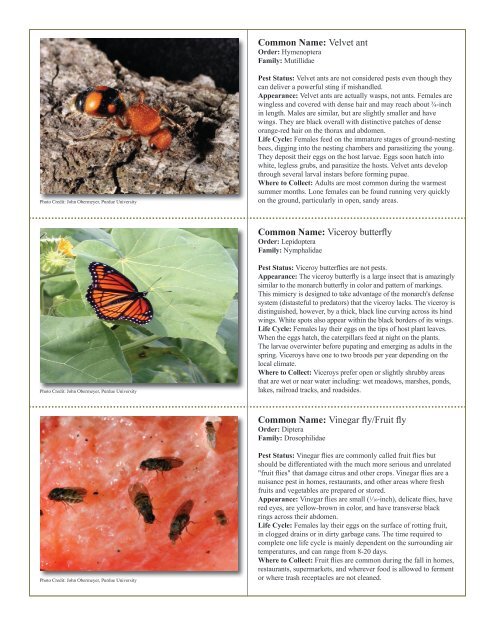to download pdf - Purdue Extension Entomology - Purdue University
to download pdf - Purdue Extension Entomology - Purdue University
to download pdf - Purdue Extension Entomology - Purdue University
Create successful ePaper yourself
Turn your PDF publications into a flip-book with our unique Google optimized e-Paper software.
Common Name: Velvet ant<br />
Order: Hymenoptera<br />
Family: Mutillidae<br />
Pho<strong>to</strong> Credit: John Obermeyer, <strong>Purdue</strong> <strong>University</strong><br />
Pest Status: Velvet ants are not considered pests even though they<br />
can deliver a powerful sting if mishandled.<br />
Appearance: Velvet ants are actually wasps, not ants. Females are<br />
wingless and covered with dense hair and may reach about ¾-inch<br />
in length. Males are similar, but are slightly smaller and have<br />
wings. They are black overall with distinctive patches of dense<br />
orange-red hair on the thorax and abdomen.<br />
Life Cycle: Females feed on the immature stages of ground-nesting<br />
bees, digging in<strong>to</strong> the nesting chambers and parasitizing the young.<br />
They deposit their eggs on the host larvae. Eggs soon hatch in<strong>to</strong><br />
white, legless grubs, and parasitize the hosts. Velvet ants develop<br />
through several larval instars before forming pupae.<br />
Where <strong>to</strong> Collect: Adults are most common during the warmest<br />
summer months. Lone females can be found running very quickly<br />
on the ground, particularly in open, sandy areas.<br />
Common Name: Viceroy butterfly<br />
Order: Lepidoptera<br />
Family: Nymphalidae<br />
Pho<strong>to</strong> Credit: John Obermeyer, <strong>Purdue</strong> <strong>University</strong><br />
Pest Status: Viceroy butterflies are not pests.<br />
Appearance: The viceroy butterfly is a large insect that is amazingly<br />
similar <strong>to</strong> the monarch butterfly in color and pattern of markings.<br />
This mimicry is designed <strong>to</strong> take advantage of the monarch's defense<br />
system (distasteful <strong>to</strong> preda<strong>to</strong>rs) that the viceroy lacks. The viceroy is<br />
distinguished, however, by a thick, black line curving across its hind<br />
wings. White spots also appear within the black borders of its wings.<br />
Life Cycle: Females lay their eggs on the tips of host plant leaves.<br />
When the eggs hatch, the caterpillars feed at night on the plants.<br />
The larvae overwinter before pupating and emerging as adults in the<br />
spring. Viceroys have one <strong>to</strong> two broods per year depending on the<br />
local climate.<br />
Where <strong>to</strong> Collect: Viceroys prefer open or slightly shrubby areas<br />
that are wet or near water including: wet meadows, marshes, ponds,<br />
lakes, railroad tracks, and roadsides.<br />
Common Name: Vinegar fly/Fruit fly<br />
Order: Diptera<br />
Family: Drosophilidae<br />
Pho<strong>to</strong> Credit: John Obermeyer, <strong>Purdue</strong> <strong>University</strong><br />
Pest Status: Vinegar flies are commonly called fruit flies but<br />
should be differentiated with the much more serious and unrelated<br />
"fruit flies" that damage citrus and other crops. Vinegar flies are a<br />
nuisance pest in homes, restaurants, and other areas where fresh<br />
fruits and vegetables are prepared or s<strong>to</strong>red.<br />
Appearance: Vinegar flies are small ( 1 ⁄10-inch), delicate flies, have<br />
red eyes, are yellow-brown in color, and have transverse black<br />
rings across their abdomen.<br />
Life Cycle: Females lay their eggs on the surface of rotting fruit,<br />
in clogged drains or in dirty garbage cans. The time required <strong>to</strong><br />
complete one life cycle is mainly dependent on the surrounding air<br />
temperatures, and can range from 8-20 days.<br />
Where <strong>to</strong> Collect: Fruit flies are common during the fall in homes,<br />
restaurants, supermarkets, and wherever food is allowed <strong>to</strong> ferment<br />
or where trash receptacles are not cleaned.
















